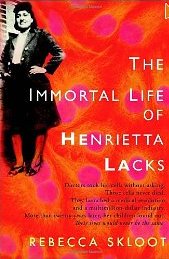January 5th, 2011 by Toni Brayer, M.D. in Better Health Network, Book Reviews, Opinion, Research
No Comments »

 If you like science, true history, and an engaging story, pick up the new book by journalist Rebecca Skloot, “The Immortal Life of Henrietta Lacks” and prepare for a great read. I knew nothing about the young black woman whose cells were taken back in 1951 by a scientist at Johns Hopkins Hospital and how those cells have revolutionized modern cell biology and research.
If you like science, true history, and an engaging story, pick up the new book by journalist Rebecca Skloot, “The Immortal Life of Henrietta Lacks” and prepare for a great read. I knew nothing about the young black woman whose cells were taken back in 1951 by a scientist at Johns Hopkins Hospital and how those cells have revolutionized modern cell biology and research.
The HeLa (named after HEnrietta LAcks) cells were taken as she lay dying on the “colored” ward at Johns Hopkins Hospital of aggressive cervical cancer at age 30. Everyone who studies basic cell biology has heard of HeLa cells because they were the first human cell line to be successfully grown in culture and they are alive today. HeLa cells were sent to researchers all across the globe and have been used to develop the polio vaccine, viruses, cloning, gene mapping and in-vitro fertilization. Billions of the same immortal HeLa cells are used by researchers fighting cancer, multiple sclerosis, heart disease, and diabetes. Read more »
*This blog post was originally published at EverythingHealth*
November 18th, 2010 by Linda Burke-Galloway, M.D. in Better Health Network, Health Tips, Research, True Stories
2 Comments »


As more older women attempt to beat the biological clock and conceive, they are at greater risk for developing birth-related complications. For women over 45, there is less than a 1 percent chance of getting pregnant using their own eggs. Successful pregnancy for women over 45 is nearly always the result of in-vitro fertilization (IVF) and the use of an egg donor.
Researchers at Tel Aviv University reviewed birth records from 2000 to 2008, specifically looking at the records of 177 women who gave birth at the age of 45 and beyond. The majority of the women had IVF and received donor eggs, and 80 percent of the babies were delivered via cesarean section (C-section).
Despite their celebrity, Kelly Presley (age 47), Celine Dion (age 42), and Mariah Carey (age 40), are older pregnant women who are at risk. The premature birth of Celine Dion’s twin sons did not surprise me at all. Women over 35, and especially those over 45 with underlying medical problems, should be treated prior to becoming pregnant. I cannot emphasize this enough. Read more »
*This blog post was originally published at Dr. Linda Burke-Galloway*
June 1st, 2010 by Peggy Polaneczky, M.D. in Better Health Network, News, Opinion, Research
1 Comment »

In the latest media barrage on autism, fertility treatment has come into question as a possible cause for this increasingly common developmental disorder. The reason is two research abstracts recently presented at the International Meeting for Autism Research in Philadelphia.
One study assessed the history of IVF (in vitro fertilization) among 574 children evaluated at a special center for autism in Israel. The researchers found that 10% of the group diagnosed as autistic had had IVF, compared to a background rate in the overall population which they quote as 3.5%. Not surprisingly, maternal age was higher in the IVF group and the rate of prematurity was higher in the autistic children.
The second study was a look into a pre-existing database — the Nurse’s Health Study — which collects data from a cohort of nurses over time. The researchers compared the reproductive history reported by women who also reported having a child with autism and compared it to that of women who did not report having an autistic child. Of those with autistic children, 48% reported infertility with 34% having used ovulation inducing drugs, compared with 33% and 24%, respectively, in women without autistic children, a difference that was statistically significant when controlled for maternal age and self-reported pregnancy complications.
A Time article getting a lot of media play calls the results of the second study “some of the strongest evidence to date” linking autism to fertility treatment. Unfortunately, that’s just not true. Read more »
*This blog post was originally published at The Blog that Ate Manhattan*
 If you like science, true history, and an engaging story, pick up the new book by journalist Rebecca Skloot, “The Immortal Life of Henrietta Lacks” and prepare for a great read. I knew nothing about the young black woman whose cells were taken back in 1951 by a scientist at Johns Hopkins Hospital and how those cells have revolutionized modern cell biology and research.
If you like science, true history, and an engaging story, pick up the new book by journalist Rebecca Skloot, “The Immortal Life of Henrietta Lacks” and prepare for a great read. I knew nothing about the young black woman whose cells were taken back in 1951 by a scientist at Johns Hopkins Hospital and how those cells have revolutionized modern cell biology and research.













